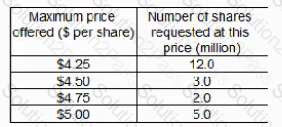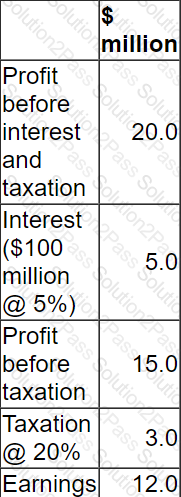F3 CIMA Financial Strategy Free Practice Exam Questions (2025 Updated)
Prepare effectively for your CIMA F3 Financial Strategy certification with our extensive collection of free, high-quality practice questions. Each question is designed to mirror the actual exam format and objectives, complete with comprehensive answers and detailed explanations. Our materials are regularly updated for 2025, ensuring you have the most current resources to build confidence and succeed on your first attempt.
Which of the following best explains why the interest rate parity model is highly effective in practice?
An unlisted company:
Is owned by the original founder and member of their families.
Is growing more rapidly than other companies in the same industry.
Pays a fixed annual divided
Which of the following methods would be the most appropriate to value this company’s equity?
An all equity financed company plans an issue of new ordinary shares to the general public to raise finance for a new project
The following data applies:
• 10 million ordinary shares are currently in issue with a market value of S3 each share
• The new project will cost S2.88 million and is expected to give a positive NPV of S1 million
• The issue will be priced at a AaA discount to the current share price.
What gam or loss per share will accrue to the existing shareholders?
Company X is an established, unquoted company which provides IT advisory services.
The company's results and cashflows are growing steadily and it has few direct competitors due to the very specialised nature of it's business. Dividends are predictable and paid annually.
Company P is looking to buy 30% of company X's equity shares.
Which TWO of the following methods are likely to be considered most suitable valuation methods for valuing company P's investment in Company X?
A company's gearing (measured as debt/(debt + equity)) is currently 60% and it is investigating whether an optimal gearing structure exists within the industry.
It has analysed the capital structure of similar companies in the industry and it would appear that there is evidence supporting the traditional theory of capital structure.
Companies with the lowest WACC in the industry have gearing of around 45% to 50%.
Which of the following actions would result in the company achieving a more optimal capital structure?
On 1 January 20X1, a company had:
• Cost of equity of 10 0%.
• Cost of debt of 5.0%
• Debt of $100Mmilion
• 100 million $1 shares trading at $4.00 each.
On 1 February 20X1:
• The company's share police fell to $3.00.
• Debt and the cost of debt remained unchanged
The company does not pay tax.
Under Modigliani and Miller's theory without lax. what is the best estimate of the movement in the cost of equity as a result of the fall in ne share price?
Company A is planning to acquire Company B. Both companies are listed and are of similar size based on market capitalisation No approach has yet been made to Company B's shareholders as the directors of Company A are undecided about the most suitable method of financing the offer Two methods are under consideration a share exchange or a cash offer financed by debt.
Company A currently has a gearing ratio (debt to debt plus equity) of 30% based on market values. The average gearing ratio (debt to debt plus equity) for the industry is 50% Although no formal offer has been made there have been market rumours of the proposed bid. which is seen as favorable to Company A. As a consequence. Company As share price has risen over the past few weeks while Company B's share price has fallen.
Which THREE of the following statements are most likely to be correct?
An entity prepares financial statements to 30 June.
During the year ended 30 June 20X2 the following events occurred:
1 July 20X1
• The entitiy borrowed $100 million at a variable rate of interest.
• In order to protect itself against the variability of its interest cashflows, the entity entered into a pay-fixed-receive-variable interest swap with annual settlements. The fair value of the swap on this date was zero.
30 June 20X2
• The entity received a net settlement of $2 million under the swap. After this net settlement, the fair value of the swap was $5 million - a financial asset.
The entity decides to use hedge accounting for this arrangement and has designated it as a cash flow hedge. The swap is a perfect hedge of the variability of the cash interest payments.
Which of the following describes the treatment of the settlement and the change in the fair value of the swap in the statement of profit or loss and other comprehensive income for the year ended 30 June 20X2?
A company raised fixed rate bank finance together with an interest rate swap for the same term and same principal value to pay floating receive fixed rate interest on an annual basis.
Which THREE of the following statements are correct?
Company A is a large well-established listed entertainment company and Company B is a small unlisted company specializing in providing online media streaming.
Company A has a gearing ratio of 60% (using book values) and interest cover of 2.
Company A is considering making an offer for Company B, either a cash offer financial by raising additional debt finance or a share-for-share exchange.
Which of the following is most likely to occur if Company A offers a share-for exchange rather than offering cash finance by raising debt?
Company A has just announced a takeover bid for Company B. The two companies are large companies in the same industry_ The bid is considered to be hostile.
Company B's Board of Directors intends to try to prevent the takeover as they do not consider it to be in the best interests of shareholders
Which THREE of the following are considered to be legitimate post-offer defences?
A company's current earnings before interest and taxation are $5 million.
These are expected to remain constant for the forseeable future.
The company has 10 million shares in issue which currently trade at $3.60.
It also has a $10 million long term floating rate loan.
The current interest rate on this loan is 5%.
The company pays tax at 20%.
The company expects interest rates to increase next year to 6% and it's Price/Earnings (P/E) ratio to move to 9.5 times by the end of next year.
What percentage reduction in the share price will occur by the end of next year if the interest rate increase and the P/E movement both occur?
A company's Board of Directors is assessing the likely impact of financing future new projects using either equity or debt.
The directors are uncertain of the effects on key variables.
Which THREE of the following statements are true?
Which of the following statements are true with regard to interest rate swaps?
Select ALL that apply.
Company A is based in Country A where the functional currency is the A$. Currently all sales are to domestic customers in Country A. However, the company is planning to expand internationally by acquiring Company B, a distribution company in Country B, to enable it to sell goods worldwide The functional currency of Country B is the BS
Company A will invoice its international customers in their local currency.
Wage increases in Country B are forecast to be modest, due to high unemployment levels, but overall inflation in Country B is forecast to be significantly higher than in Country A
Which TWO of the following statements about the economic risk of the acquisition of Company B are true?
Company C invests heavily in Research and Development an need to raise $45 million to finance future projects. It has decided to use equity finance raised by a tender offer, The following tender offers have been received from potential investors:

Company C wishes to select an offer price that will project shareholders from a significant dilution of control but still raise the required amount of finance.
What offer price should Company C’s select?
A company has in a 5% corporate bond in issue on which there are two loan covenants.
• Interest cover must not fall below 3 times
• Retained earnings for the year must not fall below $3.5 million
The Company has 200 million shares in issue.
The most recent dividend per share was $0.04.
The Company intends increasing dividends by 10% next year.
Financial projections for next year are as follows:

Advise the Board of Directors which of the following will be the status of compliance with the loan covenants next year?
STU has relatively few tangible assets and is dependent for profits and growth on the high-value individuals it employs. Which of the following statements best explains why the net asset valuator method’s considered unstable for TU?
The ex div share price of Company A’s shares is $.3.50
An investor in Company A currently holds 2,000 shares.
Company A plans to issue a script divided of 1 new shares for every 10 shares currently held.
After the scrip divided, what will be the total wealth of the shareholder?
Give your answer to the nearest whole $.

The directors of a financial services company need to calculate a valuation of their company’s equity in preparation for an upcoming initial Public Offering (IPO) of shares. At a recent board meeting they discussed the various methods of business valuation.
The Chief Executive suggested using a Price-earing (P./E) method of valuation, but the finance Director argued that a valuation based on forecast cash flows to equity would be more appropriate.
Which THREE of the following are advantages of valuation based on forecast cash flows to equity, compared to a valuating using a price earnings methods?


